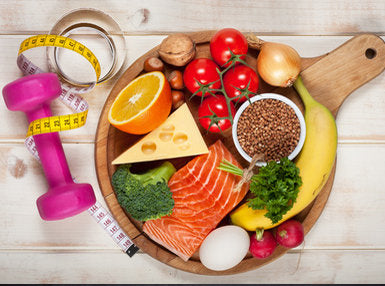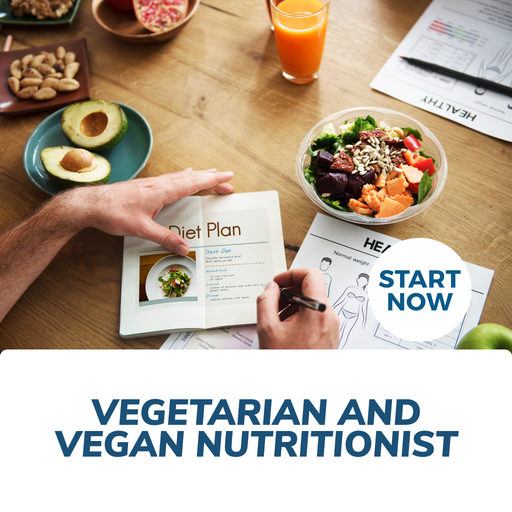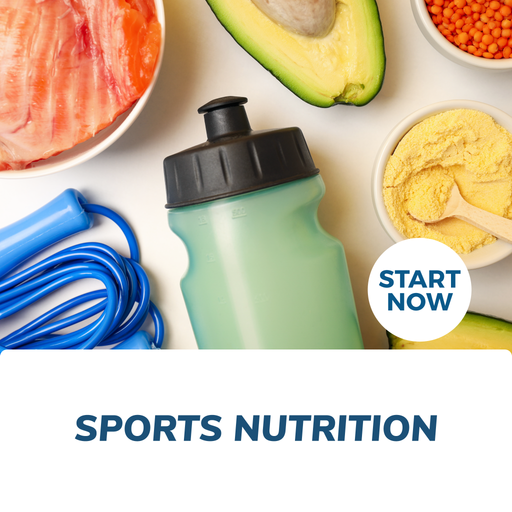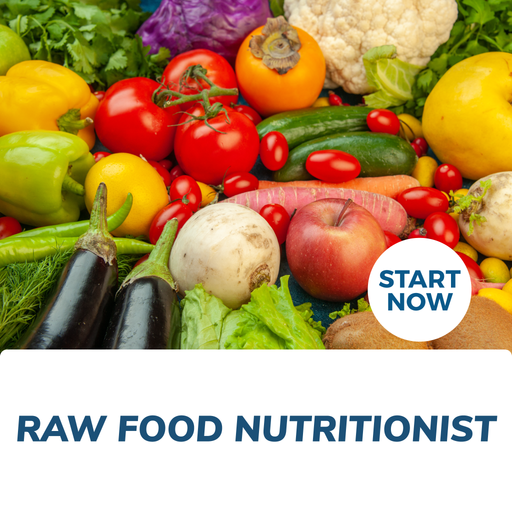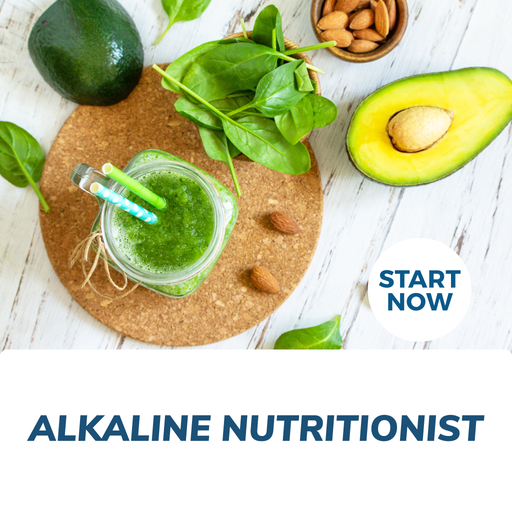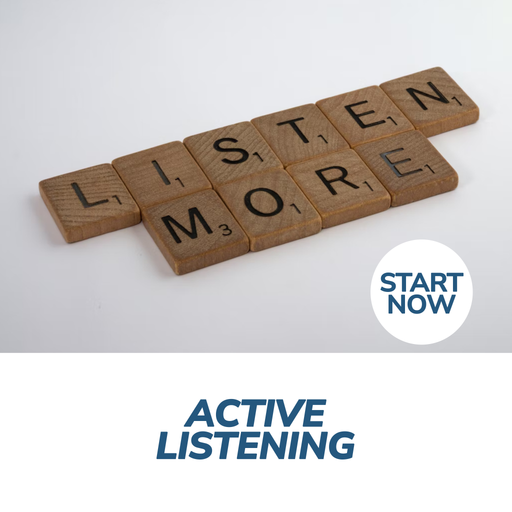
About This Course
What you will learn
|
|
Study Nutrition Online Course and learn about the fundamental principles of nutrition and responsibilities of a nutritionist
Our Nutrition Online Course outlines the tasks and responsibilities of a nutritionist. This course is meant to assist students in learning the fundamental concepts of nutrition. It will discuss in detail about diet and how it affects individual and public health. You will also learn about balanced diets and the concept of a food pyramid. Human anatomy and physiology, including digestive, muscular, skeletal, neurological, endocrine, urinary, respiratory, and circulatory systems, will also be covered. The structure and metabolism of lipids, proteins, carbohydrates, and enzymatic activity are also covered.
You will discover how to balance your diet by knowing the right mix of nutrients. Monosaccharides, disaccharides, polysaccharides, and the organs and enzymes involved in macronutrient breakdown. You will also learn about amino acids, fatty acids, and their derivatives, which are all vital. Vitamins (including Vitamins A and B), with information on their functions, benefits, deficiencies, and toxicity symptoms for each one. Minerals such as calcium, iron, phosphorus, magnesium, potassium, sodium, and others have different effects and advantages. You will learn about vitamin and mineral deficiency symptoms, as well as how they interact.
The dietary needs of women at all periods of their life, including puberty, pregnancy, and breastfeeding, will be discussed in our Nutrition Course. Nutritional needs for newborns, adolescents, and teens and the identification of eating disorders such as anorexia and bulimia. For more courses like this, you could also visit our popular Nutrition Online Courses.
Nutrition Online Course – Requirements
This course is designed for people with little or no prior experience. The course is delivered 100 percent online 24/7 and only takes a few hours of study to complete.
To successfully complete this course, a student must:
- Have access to the internet and the necessary technical skills to navigate the online learning resources
- Have access to any mobile device with internet connectivity (laptop, desktop, tablet)
- Be a self-directed learner
- Possess sound language and literacy skills
Quick Course Facts:
- Course content is structured for easy comprehension
- Registered students gain unrestricted lifetime access to your online course
- All course material is available online 24/7 and can be accessed using any device
- Study your course online from anywhere in your own time at your own pace
- All students who complete the course will be awarded with a certificate of completion that is applicable worldwide
For any additional questions please see our comprehensive FAQS tab above.
Nutrition Online Certificate Course Outline
Module 1: Introduction
Welcome to the nutrition introduction module of this course. Nutrition is a branch of science that studies the impact of well-balanced nutrients on the human body's growth, development, and well-being. Principles from biology, biochemistry, and physiology are combined in this subject. It also looks into the psychological and cultural factors that impact a person's food preferences and the health effects that arise.
History of Nutrition
Nutrition as a discipline has a long history, dating back to 400 BCE, when humans began to utilize food to heal their ailments. People have depended on tales and word of mouth to understand how diet and physical health interact for generations. Scientists began to speculate that there was more to food than previously believed as major cures were discovered and study advanced.
Why is Nutrition Important?
A person's life span can be extended by getting appropriate nourishment through a healthy, balanced diet. carbs, animal proteins, vitamin-rich fruits and vegetables, and foods high in fiber are all part of a healthy eating plan. A well-balanced diet is always high in nutrients and minerals that are helpful to the body. It is, nevertheless, possible to consume too much of a good thing. In order to prevent consuming too many calories or too much of one sort of nutrient, a diet must also be balanced.
Nutrition and Disease
A well-balanced diet is beneficial not only to your physical health, but also to your mental well-being. This entails avoiding possibly dangerous chemicals and foods with high sugar or carbohydrate content.
Life Stages
The importance of nutrition is not limited to children; it is crucial at all stages of life. Many adults are concerned about their children's dietary intake without considering their own.
Module 2: Protein
Proteins and their significance in general health will be discussed in Module 2. Phytonutrients are macronutrients that include protein. To put it another way, the body need a considerable amount of it to maintain life. Protein accounts for around 15% of a person's weight.
What is Protein?
The hundreds of proteins found in the human body are made up of twenty amino acids that combine in diverse configurations.
Growth
For tissue development and maintenance, protein is required in the body. The body breaks it down and distributes it as required. Protein is found in our muscles, organs, eyes, hair, and skin.
Energy
Protein is a key energy source. Your body uses surplus protein that isn't utilized for bodily upkeep and repair as energy.
Hormones
Proteins are involved in the creation of hormones, which aid in the regulation of body activities. Insulin, for example, is a tiny hormone that controls blood sugar levels.
Movement of Molecules
A key role of proteins in the transportation and storage of specific substances Hemoglobin, a protein, transports oxygen throughout the body, for example.
Antibodies
Antibodies are proteins found in the blood that aid the body's defense against dangerous antigens like bacteria and viruses in the battle against them. They play an important function in the prevention of infection and illness in this way.
Protein Deficiency
When a person's daily dietary intake is insufficient to satisfy the body's requirements, protein insufficiency arises. This is very common in underdeveloped countries. Individuals in industrialized nations, on the other hand, who have an unbalanced diet may be impacted.
Sources of Protein
Adults should consume 0.75 grams of protein for every kilo of body weight to maintain a balanced diet. Protein may be found in a variety of meals, including meat and fish.
Supplements
Protein supplements may be used by some persons to complement their nutritional consumption. When you don't have time for a regular breakfast in the morning, protein supplements are a quick method to add protein to your diet.
Module 3: Carbohydrates
Carbohydrates and their role in the body will be discussed in this unit. Carbohydrates, sometimes known as "carbs," are found in a variety of meals, not simply sweets.
The Roles of Carbohydrates
Fruit, cereals, milk, and vegetables are all sources of carbohydrates. They are a critical macronutrient that provides energy to the human body. The body may utilize the surge of energy from the process to fuel muscles and cells when carbs are broken down.
Balanced Intake
When you consume too many carbs, your body is put under a high metabolic strain. The body begins to have health concerns if it is unable to filter out excess glucose or store it in the liver as glycogen. Weight gain, an increased risk of heart disease, an inefficient metabolism, and growing sensitive to illnesses like diabetes are all examples of these health issues.
Glycemic Index and Glycemic Load
The glycemic index is a numeric value ranging from 0 to 100 that is given to foods based on their blood sugar effects. When a food's glycemic index is lower, it suggests that blood sugar increases more slowly after consuming it.
Simple and Complex Carbohydrates
The number of sugar molecules in a carbohydrate determines how complex it is. Simple carbohydrates are quickly broken down and converted to glucose, which the body then uses for energy. Complex carbohydrates take longer to digest, giving the body more energy over time. Both forms of carbs are beneficial to the body.
Sources of Carbohydrates
Many foods, including some that consumers may not expect, contain carbohydrates. Complex carbs are thought to be healthier for the body since the time it takes to break them down translates to a more constant energy deposit into the bloodstream. This is because complex carbohydrates take longer to break down. It's also crucial to restrict or avoid meals high in refined grains' carbs. Refined grains occur when certain constituents of the native grain have been eliminated. This indicates that the grains are devoid of fiber, numerous minerals, and healthful fats.
Module 4: Fats
A widespread misunderstanding is that all fats are harmful, however this is not the case. Fats are a significant source of energy that are involved in a variety of biological processes.
Roles of Fats
Similarly, to the other two key macronutrients, protein and carbs, fats are a significant source of energy for the human body. Of these nutrients, fat is the most concentrated, giving 9 calories for every gram that is taken.
Fatty Acids
Fatty acids are the building blocks of fat, which may be found in both food and the body. During digestion, lipids in your diet are broken down into fatty acids, which are then absorbed into your bloodstream. Long chains of carbon atoms linked by certain hydrogen atoms make up fatty acids. The different fatty acids are created by small changes in structure.
Sources of Fat
It's no surprise that fats can be found in a wide range of foods because there are so many different types of fat.
- Common sources of saturated fat include pizza, cheese, dairy products, cookies, and meat such as sausage, beef, and bacon.
- Monounsaturated fats are present in large quantities in avocados, nuts, and seeds. They can also be found in olive, peanut, and canola oils.
Fat and Cholesterol
Cholesterol is a lipid that is generated in the liver and is similar to fat. While cholesterol is necessary for numerous body activities, including vitamin D creation, steroid hormone production, and bile formation, too much can cause major health problems.
Obesity in America
In 2017, the US Department of Agriculture issued a research that looked at how food consumption habits have changed over the last 40 years. According to the research, Americans are consuming more of the major dietary categories. They do, however, consume excessive amounts of fats, sugar, and grains, as well as a lack of fruits and vegetables.
Module 5: Micronutrients
Micronutrients such as vitamins and minerals aid in the body's function, development, and health maintenance.
Micronutrients and Macronutrients
Micronutrients are significantly more diverse and harder to come by. Micronutrients must be absorbed from various types of food because they are not created inside the body. Micronutrients are named thus because the human body only requires little amounts of them to carry out its tasks, as the prefix implies.
Defining Vitamins and Minerals
Vitamins are required for energy synthesis, immunity, and blood coagulation in the body. Calcium and magnesium, on the other hand, are essential for development, bone health, fluid equilibrium, and other functions.
Types of Vitamins
Water soluble and fat-soluble vitamins are the two types of vitamins. Intake of water on a regular basis is how the first kind enters the body. They are difficult to keep in the body and, if ingested in excess, are flushed out through the urine.
Types of Minerals
Macrominerals and trace minerals are two types of minerals. Although trace minerals are required in lesser amounts, both of these categories are significant to the organism. Although macronutrients are commonly ingested in conjunction with macronutrients, the human body requires them in greater quantities. Despite the fact that they are required in a smaller amount, trace minerals are just as significant.
Sourcing Vitamins and Minerals
To sustain functioning and health, the body requires a steady intake of nutrients such as micro and macronutrients. Here are a few examples of foods that are high in it.
- Chicken, cereals, spinach, turkey, beef shank, oysters, nuts like cashews, legumes, potatoes with skin, broccoli, and kiwi fruit are all good sources of trace minerals.
- Citrus fruits, eggs, salmon, leafy greens, whole grain, and lean meat are all sources of water-soluble vitamins.
Supplements
In the case of vitamin or mineral shortages, the body isn't getting enough nourishment to operate effectively. Dietary limitations or a lack of awareness of food and its qualities might be the cause.
Module 6: Metabolism
It is critical to the study of people and animals alike since metabolism is an important mechanism that underpins their proper functioning. We'll also look at how distinct metabolisms some people have when compared to others. The metabolic rate of a person is frequently referred to as this.
Defining Metabolism
All of the many chemical processes going on inside the human body are referred to as metabolism. These processes are necessary for the body's proper functioning and occur on a regular basis.
In humans, there are a variety of mechanisms that contribute to metabolic systems. All of these activities, from the process of breaking down nutrients in our meals to the process of repairing and developing our bodies, make up metabolism.
Individual Differences
People might have similar physical characteristics yet have radically distinct metabolisms. When one individual consumes excessive food, he may acquire little to no weight, whilst the other must constantly monitor their diet in order to avoid weight gain.
Metabolic Rate
The entire energy expenditure of a person is referred to as the metabolic rate. The metabolic rate may be broken into three parts:
Basal Metabolic Rate (BMR)
This statistic, often known as the resting metabolic rate, accounts for the energy expended during rest to perform essential biological activities such as breathing and blood circulation through heartbeat.
Thermic Effect of Food
Thermogenesis is another name for it. This refers to the use of energy during the digestion of food and beverages, as well as the breakdown, transport, and storage of nutrients. Thermogenesis consumes about 5 to 10% of our energy resources.
Physical Activity
This is the amount of energy that humans require in order to perform various activities and workouts. Walking, playing with a dog, or leaping are all simple activities that may use a lot of energy. This can account for up to 20% of a person's overall energy expenditure if they are merely moderately active, which is defined as 30 to 50 minutes of physical activity each day.
Catabolism and Anabolism
Despite the fact that our metabolism is so complicated, there are two distinct elements to it: catabolism and anabolism. They are regulated by the body in order to keep things in check.
- Catabolism is the process through which dietary components such as carbohydrates, fats, and proteins are broken down into far simpler molecules that may be utilized to create energy. They also serve as the building blocks for cell development and repair.
- Anabolism is the component of our metabolism that deals with our body's construction and repair. The food we eat provides the energy required for this. Fat is deposited when a person eats more food than is required for construction and repair.
Metabolic Disorders and Symptoms
When specific organs of the body cease working correctly, the majority of metabolic problems emerge. The pancreas and liver, for example, are vital organs in metabolism.
- A hereditary component causes diabetes, which is likely the most common metabolic disorder. Diabetes causes a shortage of insulin, which can lead to secondary complications such as renal damage, cardiovascular disease, and vision loss.
- Gaucher's disease is a disorder in which the body is unable to break down a certain type of fat, which is instead stored in organs such as the liver, bone marrow, and spleen. Pain and bone damage are two of the symptoms. It has the potential to kill. Enzyme replacement is frequently used to treat it.
Module 7: Nutrition and Aging
Nutrition as it pertains to aging will be discussed in this section of the course. The nutritional requirements of a person do not remain constant over time. As the individual in question progresses through life stages, they continue to change.
Risks
Understanding the impact of aging on nutrition is critical for prospective nutrition experts. There is no one-size-fits-all method to managing nutritional demands because a person's life stage can have a significant impact on how they absorb nutrients.
Nutritional Needs
Changes aren't always bad. Some are just unavoidable situations that necessitate some simple lifestyle changes.
- In advanced age, the body typically requires more nutrients but fewer calories. However, the number of calories needed by an individual still varies with activity, muscle mass, weight, and height.
- Maintaining the same caloric intake as younger people with lower activity levels may result in belly fat, which is especially common in post-menopausal women. However, fat can accumulate in other places throughout the body, leading to obesity in people of all genders.
Nutritional Deficiencies
Adaptation is required as we age. Nutritional requirements can change rapidly as the body ages. People who are unaware of this fact are more likely to acquire nutritional deficiencies if they continue to eat the same meals they did when they were younger.
- Iron: Iron deficiency, which can lead to anemia, is more common in older persons (low red blood cell count). In elderly persons, anemia can induce fatigue. Spoon-shaped nails, in which the nail has a curved shape from the bed, may also affect older adults. Koilonychia is the name for this deficiency. Shellfish and liver are excellent sources of iron, which will aid in the prevention of these problems.
- The absence of essential fatty acids (omega 3) or protein in an older adult's hair can create dry and brittle hair. A vitamin deficit might potentially be the cause of unusual hair loss.
Dehydration
Most people neglect water while discussing nutrition. Because water makes up to 60% of the body and is continually excreted through urine and perspiration, hydration is critical. For elderly persons, the risk of dehydration may be increased. The sensitivity of the brain receptors that detect thirst decreases as people become older.
Lack of Appetite
Appetite loss can lead to dietary deficits and accidental weight loss. Changes in scent, living circumstances, loneliness, drugs, underlying sickness, tooth loss, and taste, in addition to hormones, may be to blame for a lack of appetite in older adults.
Module 8: Infants, Children, and Teens
Nutrition for younger age groups is the emphasis of this subject. To develop and operate properly, infants, adolescents, and teenagers require important nutrients. As an infant's bodily system grows, so do their nutritional requirements as they grow.
Infants
Because they are at a stage of fast growth, infants have unique dietary requirements. During the first year of life, virtually every system of the body expands and develops at the same time.
For babies, energy is a crucial dietary need. Based on the infant's weight, the infant's energy need is given as the number of kilocalories required per unit. An infant's specific calorie requirements may be influenced by factors such as body size, size at birth, physical activity, sex, hereditary factors, medical issues, and even ambient temperature.
Breast Milk
Breast milk is abundant in macronutrients, micronutrients, and other bioactive components, making it extremely nutritious for newborns. Breastmilk has a well-balanced nutritional composition, which some parents and caregivers may not utilize.
Children
Children aged 2 to 4 require 1000 to 1400 calories per day, whereas children aged 5 to 8 require 1200 to 2000 calories per day. Maintaining a healthy diet hinges on how these calories are divided. Obesity and poor eating habits in children can be prevented by striking a balance early in life. Furthermore, consuming a variety of meals can help identify any food sensitivities early on and treat them appropriately to lessen their impact.
Teenagers
Teenagers may make poor nutritional choices because they have more autonomy than younger children. Teenagers may be exposed to the following dangers as a result of unbalanced, poor diets:
- Obesity in teens increases the risk of high blood pressure, heart disease, and high cholesterol levels.
- Calcium deficiencies in teens' diets may raise their chance of getting osteoarthritis and weak bones when they reach maturity, according to the American Osteopathic Association.
Causes of Childhood Obesity
Due to hereditary causes, a kid may be prone to obesity. However, only around 5% of occurrences of childhood obesity may be completely linked to heredity. Children's excess weight gain may be caused by overconsumption of processed meals high in salt, sugar, and fat. Even healthy choices can have the same impact when eaten in large volumes.
Module 9: Special Considerations
We'll go through any unusual circumstances that could arise that necessitate specific nutritional requirements. There are a variety of scenarios that might arise in a person's life, whether they occur on a daily or irregular basis.
Individual Circumstances
A person's dietary needs may differ from those of their age group, gender, or other factors. Pregnancy, menopause, periods of high-level sports training, or any continuing sickness are all examples of unique conditions.
Pregnancy
Pregnancy necessitates a greater focus on a woman's dietary requirements. The requirement for additional calories later in pregnancy is one of the most noticeable changes. People will require roughly 300 more calories per day when pregnant than they would normally consume.
Menopause
It's critical to eat calcium-rich foods like different types of fish, broccoli, and legumes throughout menopause. Calcium is also abundant in dairy products. At this time, persons should consume at least 1,200 mg of calcium each day.
High-Level Athletic Training
Active folks are continually exhausting themselves of energy when conducting high-intensity physical training. For the body to work at a continuously high level, it requires large amounts of calories, carbs, and water, as well as other minerals.
Chronic Illness
Dietary limitations may be present in those with chronic illnesses.
- With a few exceptions, it is generally acknowledged that fruits and vegetables are necessary even during sickness.
- Potatoes, rice, and pasta, which are high in fiber and carbs, can be a mainstay for controlling certain diseases. Fiber-rich foods have been shown to lessen the risk of heart disease and diabetes in clinical studies.
Module 10: Nutritional Labeling
The course's nutritional labeling and the types of information that normally accompany food are discussed in this part. Additionally, we'll go through the particular criteria for organic fruit and other items.
Oversight
In the United States, food labeling is regulated by the following federal agencies: United States Department of Agriculture (USDA), the United States Food & Drug Administration (FDA), and the United States Federal Trade Commission (FTC).
Because it allows people to make educated decisions about the food they buy and eat, nutritional information is critical. It also allows the maker to show off the components in their dish and warn potential buyers about any possible food allergies. If the customer has easy access to this knowledge, they may maintain a balanced and nutritious diet if they so want. There is also a warning message for individuals to follow in order to avoid any food additives they feel are hazardous to them or the environment.
Organic Requirement
Companies can refer to their products as organic or not, according to the United States Department of Agriculture. Food must meet the following conditions in order to meet these standards:
- Organic ingredients must account for at least 95% of the food.
- The remaining 5 percent must be made up of USDA-approved foods.
- An authorized agency must certify the products.
- Only authorized organic methods can be used to manufacture foods.
Module 11: Nutritional Psychology
The interaction between the mind and eating behaviors is explored in this specialized domain.
Defining Nutritional Psychology
Nutrition and psychology are two fields that are inextricably linked. The way a person's normal food affects their physical health is governed by nutrition. It also has an impact on how the body absorbs nutrients from its dietary intake.
Medical Professionals
Nutritional psychology is a broad area that encompasses a wide range of medical professions. These experts apply their dietary and psychological skills to improve their customers' physical well-being.
- Clinician: Clinicians play an important role in every healthcare establishment. They have the responsibility of delivering direct patient care. It is the clinician's responsibility to manage a patient's symptoms while also attempting to minimize their impact on the patient.
- Coaching for athletes and other professions: Many conditioning coaches work with athletes and other professionals to keep them in shape. Nutritional psychology aids these conditioning trainers in prescribing the appropriate meals to improve their clients' physical appearance. They also know the best foods to use to keep such individuals in the best possible mental condition.
Food and Mental Health
As a reward, some people treat themselves to special meals. In the long run, this practice of giving meals a mental reward might be harmful. Food has a variety of additional effects on a person's mental health. The human brain, for example, has a strong relationship to the gastrointestinal tract. Bacteria in this gastrointestinal system release chemical compounds that transport particular messages from the stomach to the brain.
Eating Disorders
Eating disorders are situations in which a person's eating habits are persistent, resulting in severe negative effects on one's health and emotions. These behaviors have the potential to undermine a person's physical and mental health. Binge eating and anorexia nervosa are two of the most frequent eating disorders.
Effects and Symptoms
If left uncontrolled, eating disorders can have serious long-term consequences. Malnourishment can cause harm to a person's important organs. When the brain does not acquire enough nourishment, it begins to operate at a lesser level.
Some of the most common effects of eating disorders include:
- Risk of heart failure
- Low blood pressure
The symptoms that come with an eating disorder can appear in several forms. These symptoms can hurt the physical and psychological state of an individual. Some of the most common symptoms include:
- Extreme mood swings
- Concern with physical appearance
Module 12: Careers and Education
The course's last module will focus on nutrition occupations and the education that is normally necessary for each. Nutrition, like other medical professions, comprises a variety of providers and support workers.
Training and Education
If you want to work in the subject of nutrition, you'll need to meet a few educational requirements. Most nutritionists have one or more of the following degrees from a recognized institution on a basic level:
- Associate of Science in a relevant field
- Bachelor of Science in Nutrition Sciences
- Master of Science in Nutrition Sciences
Registered Dietician
Depending on your passion, you might explore for a variety of employment options in the subject of nutrition. The registered dietician is one of the most advanced of them. A registered dietitian (RD) is a professional who has passed a stringent series of tests and qualifications.
Dietetic Technicians
Dietetic technicians have also received extensive training. In general, they are responsible for the following tasks:
- Creating nutritional reports
- Promoting the significance of nutrition to clients
- Surveys and research data collection
- Assisting in the creation of nutritionally balanced meals
Recognition & Accreditation
Upon successful completion of this course and achieving a passing score for the assessment, you will be issued with an international continuing education credit (CEU) certificate.
This Certificate is applicable worldwide, which demonstrates your commitment to learning new skills. You can share the certificate with your friends, relatives, co-workers, and potential employers. Also, include it in your resume/CV, professional social media profiles and job applications.
Units of Study
Module 1: Introduction
- History of Nutrition
- Major Figures
- Why is Nutrition Important?
- Nutrition and Disease
- Life Stages
Module 2: Protein
- What is Protein?
- Growth
- Energy
- Hormones
- Movement of Molecules
- Antibodies
- Protein Deficiency
- Sources of Protein
- Supplements
Module 3: Carbohydrates
- The Roles of Carbohydrates
- Balanced Intake
- Glycemic Index and Glycemic Load
- Simple and Complex Carbohydrates
- Sources of Carbohydrates
Module 4: Fats
- Roles of Fats
- Fatty Acids
- Sources of Fat
- Fat and Cholesterol
- Obesity in America
Module 5: Micronutrients
- Micronutrients and Macronutrients
- Defining Vitamins and Minerals
- Types of Vitamins
- Types of Minerals
- Sourcing Vitamins and Minerals
- Supplements
Module 6: Metabolism
- Defining Metabolism
- Individual Differences
- Metabolic Rate
- Basal Metabolic Rate (BMR)
- Thermic Effect of Food
- Physical Activity
- Catabolism and Anabolism
- Metabolic Disorders and Symptoms
Module 7: Nutrition and Aging
- Risks
- Nutritional Needs
- Nutritional Deficiencies
- Dehydration
- Lack of Appetite
Module 8: Infants, Children, and Teens
- Infants
- Breast Milk
- Children
- Teenagers
- Causes of Childhood Obesity
Module 9: Special Considerations
- Individual Circumstances
- Pregnancy
- Menopause
- High-Level Athletic Training
- Chronic Illness
Module 10: Nutritional Labeling
- Oversight
- Organic Requirement
- Case Study: Snapple Lawsuit
Module 11: Nutritional Psychology
- Defining Nutritional Psychology
- Medical Professionals
- Food and Mental Health
- Eating Disorders
- Effects and Symptoms
Module 12: Careers and Education
- Training and Education
- Registered Dietician
- Dietetic Technicians
- Sports Nutritionist
- Animal Nutritionist
- Health Coach
- Work Environments
- Collaborative Care Teams
- The Benefits if Working in Nutrition Science
- Case Study: Registered Dietician
Requirements
Entry requirements
Students must have basic literacy and numeracy skills.
Minimum education
Open entry. Previous schooling and academic achievements are not required for entry into this course.
Computer requirements
Students will need access to a computer and the internet.
Minimum specifications for the computer are:
Windows:
Microsoft Windows XP, or laterModern and up to date Browser (Internet Explorer 8 or later, Firefox, Chrome, Safari)
MAC/iOS
OSX/iOS 6 or laterModern and up to date Browser (Firefox, Chrome, Safari)
All systems
Internet bandwidth of 1Mb or fasterFlash player or a browser with HTML5 video capabilities(Currently Internet Explorer 9, Firefox, Chrome, Safari)
Students will also need access the following applications:
Adobe Acrobat Reader
Requirements
Entry requirements:
Students must have basic literacy and numeracy skills.
Minimum education:
Open entry. Previous schooling and academic achievements are not required for entry into this course.
Device requirements:
Students will need access to a computer/any device and the internet.
FAQS
1. Who are Courses For Success?
Courses For Success is a course platform that started in 2008
with 5 courses, since then we have grown to over 10,000 online courses.
Our courses span across the following categories:
•Animal
•Beauty
•Business
•Health & Fitness
•Finance
•Lifestyle
•IT & Software
•Personal Development
•Teaching & Academics
2. Is there a refund/cancellation policy?
Yes, we have a 7-day money-back refund guarantee. Just send us an email to info@coursesforsuccess.com with the subject Courses For Success Refund so we can accommodate your request.
3. What is the FREE Personal Success Training Program?
The Personal Success Training Program
was developed by Courses For Success to help our customers achieve
success. Currently, we are offering this program for FREE with every
course or bundle purchase this month. This is a limited time offer!
4. Are there any requirements to study this course?
No,
anyone who has an interest in learning more about this subject matter
is encouraged to take our course. There are no entry requirements to
take this course.
5. Do I require to have finished high school to complete this course?
No,
you do not require a High School Diploma or to have finished school to
study this course, this course is open to anyone who would like to take
this course.
6. What if English is not my first language?
This
course is provided in English, however, due to the digital nature of
our training, you can take your time studying the material and make use
of tools such as google translate and Grammarly.
7. Is this course online or conducted in person?
All our courses are accessible online on any device. You may complete them at your own pace and at your own time.
8. How do I receive my course?
After
you have completed the payment, you will receive a confirmation email
and tax receipt. You will also receive an email containing your course
login details (username and password), as well as instructions on how to
access and log in to your course via the internet with any device,
please check your junk/spam folder in the event that you do not receive
the email.
9. When does this course start?
Providing
you have internet access you can start this course whenever you like,
just go to the login page and insert your username and password and you
can access the online material.
10. What is online learning like?
Online learning is easy, if not easier than a traditional academic situation.
By studying an online course, the usual boundaries caused by location and time constraints are eliminated, meaning you are free to study where and when you want at your own pace.
Of course, you will need to be able to self-manage your time and be organized, but with our help, you’ll soon find yourself settling into a comfortable rhythm of study.
11. What computer skills do I need for my course?
You
don't need to be a computer expert to succeed with our online training,
but you should be comfortable typing, using the internet and be capable
of using common software (such as Microsoft word).
12. How long will you have access to the online course?
The majority of our courses have unlimited lifetime access, meaning you can access this course whenever you want.
Please also check the course summary, as a small selection of courses have limited access.
13. How long will my course take?
Course duration, is listed under Course Summary
14. Do I need to buy textbooks?
All the required material for your course is included in the online system, you do not need to buy anything else.
15. Is the course interactive?
Yes, all our courses are interactive.
16. Is there an assessment or exam?
Yes,
you will be required to complete a multiple-choice test online at the
end of your course, you can do this test as many times as you require.
17. What type of certificate will I receive?
You
will receive a Certificate of Completion that is applicable worldwide,
which demonstrates your commitment to learning new skills. You can share
the certificate with your friends, relatives, co-workers and employers.
Also, include it in your resume/CV, professional social media profiles
and job applications.
Wendy Sue Hunt - 5 STAR REVIEW
"If you are considering taking any “Courses for Success”, I would highly recommend it. I have always been a firm believer it’s important to always sharpen your skills. You are never too old to learn more. I found the courses very helpful, interesting and easy to understand.
The term “Courses for Success” helped me in my current position to succeed. After completing the courses, I gave my manager the completion certificates. Recently I received a promotion too."
Valencia Marie Aviles - 5 STAR REVIEW
"I
had a very good experience with my course. It has helped me to get
multiple jobs and prepared me for almost everything I would need to
know. The course was very informative and easy to understand and broken
up perfectly to be done in a short amount of time while still learning a
good amount! I would recommend Courses for Success to anyone trying to
get abs certifications for job advancements, it is well worth it!"
ELENA GRIFFIN - 5 STAR REVIEW
"I have absolutely enjoyed the materials from Courses for Success. The materials are easy to understand which makes learning enjoyable. Courses for Success have great topics of interest which make you come back for
more.
Thank you Courses for Success for being part of my learning journey and making education affordable!"
Our
completion certificates are very valuable and will help you progress in
your work environment and show employers how committed you are to learn
new skills, you might even get a promotion.
18. Will this course be credited by universities?
No, it is not equivalent to a college or university credit.
19. Am I guaranteed to get a job with this certificate?
This course will give you the skills you need to help you obtain employment, but it’s up to you if you get the job or not.
20. How will this course assist me with my career?
Studying
and completing this course will show employers that you have the
knowledge in this field, additionally you will gain more confidence in
this area of expertise.
21. How long is the certificate valid for?
The Certificates are valid for life and do not need renewing.
22. Can I take more than one course at a time?
Courses
are studied online at your own pace and you are free to study as many
or as few courses as you wish, we also offer online course bundles that
allow you to save on additional courses so that you may get all the
topics related to your training goals in one go.
23. What are the Payment Methods available? Is there a payment plan?
We accept payments via PayPal, Credit Card and Bank Transfer.
Payment Plans: We have partnered with Partial.ly, to offer our own in house payment plan. Everyone is Pre-Approved, providing the initial deposit is paid in full.
To pay via bank transfer contact us info@coursesforsuccess.com
24. Can I purchase for multiple people?
Yes, you can do this by purchasing individually via website or send us a request via email at info@coursesforsuccess.com
25. Can I request for an invoice before purchase?
Yes, you can request for an invoice via email at info@coursesforsuccess.com
26. Purchase for a gift?
Yes, you can purchase this course as a gift, simply send an email to info@coursesforsuccess.com, with the course details and we can accommodate this.
27. Can I create my own course bundle?
Yes,
you can customize your own bundle. Please send us the complete list
with the exact course link of the courses you'd like to bundle up via
email info@coursesforsuccess.com and we will create them for you. *Each course access, time of completion and certification varies depending on the course type.
28. How will I contact Courses For Success if I have any questions?
You can contact our support team, at any time through live chat on our website, or email at info@coursesforsuccess.com, or by calling one of our phone numbers depending on which country you are in.
Free Personal Success Training Course
The Personal Success Training Program Helps You Stay Focused To Achieve Your Goals!
This month, we are providing it for Free with all Course Purchases, as a special offer!
Benefits:
• How to layout a Success Plan.
• Get where you want to be in life.
• How to unclutter your mind to succeed.
• Achieve your dreams using your imagination.
• How to have faith in yourself.
Features:
• Life time access
• Complement your individual course purchase.
• Click here Personal Success Training Program to see thousands of positive reviews,
Hurry - offer - ends this month!
Course Bundles
Looking for specific training for yourself or employees. Choose from our Course Bundles below or build you own Bundle, by adding more courses to your cart. Choose different courses or the same course for multiple staff members and receive volume discounts at checkout.
Nutrition Online Certificate Course
"it was an amazing experience. Not only did I learn the fundamental concepts of nutrition and diet, but I also gained valuable insight into how it affects individual and public health. The course was well-structured and easy to follow, with helpful tips provided throughout to help me understand the material better. Highly recommended for anyone interested in nutrition!" - Evelyn S. Verified Buyer
With this Nutrition course, you will learn the fundamental concepts of nutrition and diet and how it affects individual and public health.
Bundle Up & Save - Learn More and Save More when you Upgrade to the Mega Bundle below & Save 98%
Course Summary
- Delivery: Online
- Access: Unlimited Lifetime
- Time: Study at your own pace
- Duration:20 Hours
- Assessments: Yes
- Qualification: Certificate
3 DAY SALE - ENDS 17 APRIL
GET IN NOW & SAVE!
About This Course
What you will learn
|
|
Study Nutrition Online Course and learn about the fundamental principles of nutrition and responsibilities of a nutritionist
Our Nutrition Online Course outlines the tasks and responsibilities of a nutritionist. This course is meant to assist students in learning the fundamental concepts of nutrition. It will discuss in detail about diet and how it affects individual and public health. You will also learn about balanced diets and the concept of a food pyramid. Human anatomy and physiology, including digestive, muscular, skeletal, neurological, endocrine, urinary, respiratory, and circulatory systems, will also be covered. The structure and metabolism of lipids, proteins, carbohydrates, and enzymatic activity are also covered.
You will discover how to balance your diet by knowing the right mix of nutrients. Monosaccharides, disaccharides, polysaccharides, and the organs and enzymes involved in macronutrient breakdown. You will also learn about amino acids, fatty acids, and their derivatives, which are all vital. Vitamins (including Vitamins A and B), with information on their functions, benefits, deficiencies, and toxicity symptoms for each one. Minerals such as calcium, iron, phosphorus, magnesium, potassium, sodium, and others have different effects and advantages. You will learn about vitamin and mineral deficiency symptoms, as well as how they interact.
The dietary needs of women at all periods of their life, including puberty, pregnancy, and breastfeeding, will be discussed in our Nutrition Course. Nutritional needs for newborns, adolescents, and teens and the identification of eating disorders such as anorexia and bulimia. For more courses like this, you could also visit our popular Nutrition Online Courses.
Nutrition Online Course – Requirements
This course is designed for people with little or no prior experience. The course is delivered 100 percent online 24/7 and only takes a few hours of study to complete.
To successfully complete this course, a student must:
- Have access to the internet and the necessary technical skills to navigate the online learning resources
- Have access to any mobile device with internet connectivity (laptop, desktop, tablet)
- Be a self-directed learner
- Possess sound language and literacy skills
Quick Course Facts:
- Course content is structured for easy comprehension
- Registered students gain unrestricted lifetime access to your online course
- All course material is available online 24/7 and can be accessed using any device
- Study your course online from anywhere in your own time at your own pace
- All students who complete the course will be awarded with a certificate of completion that is applicable worldwide
For any additional questions please see our comprehensive FAQS tab above.
Nutrition Online Certificate Course Outline
Module 1: Introduction
Welcome to the nutrition introduction module of this course. Nutrition is a branch of science that studies the impact of well-balanced nutrients on the human body's growth, development, and well-being. Principles from biology, biochemistry, and physiology are combined in this subject. It also looks into the psychological and cultural factors that impact a person's food preferences and the health effects that arise.
History of Nutrition
Nutrition as a discipline has a long history, dating back to 400 BCE, when humans began to utilize food to heal their ailments. People have depended on tales and word of mouth to understand how diet and physical health interact for generations. Scientists began to speculate that there was more to food than previously believed as major cures were discovered and study advanced.
Why is Nutrition Important?
A person's life span can be extended by getting appropriate nourishment through a healthy, balanced diet. carbs, animal proteins, vitamin-rich fruits and vegetables, and foods high in fiber are all part of a healthy eating plan. A well-balanced diet is always high in nutrients and minerals that are helpful to the body. It is, nevertheless, possible to consume too much of a good thing. In order to prevent consuming too many calories or too much of one sort of nutrient, a diet must also be balanced.
Nutrition and Disease
A well-balanced diet is beneficial not only to your physical health, but also to your mental well-being. This entails avoiding possibly dangerous chemicals and foods with high sugar or carbohydrate content.
Life Stages
The importance of nutrition is not limited to children; it is crucial at all stages of life. Many adults are concerned about their children's dietary intake without considering their own.
Module 2: Protein
Proteins and their significance in general health will be discussed in Module 2. Phytonutrients are macronutrients that include protein. To put it another way, the body need a considerable amount of it to maintain life. Protein accounts for around 15% of a person's weight.
What is Protein?
The hundreds of proteins found in the human body are made up of twenty amino acids that combine in diverse configurations.
Growth
For tissue development and maintenance, protein is required in the body. The body breaks it down and distributes it as required. Protein is found in our muscles, organs, eyes, hair, and skin.
Energy
Protein is a key energy source. Your body uses surplus protein that isn't utilized for bodily upkeep and repair as energy.
Hormones
Proteins are involved in the creation of hormones, which aid in the regulation of body activities. Insulin, for example, is a tiny hormone that controls blood sugar levels.
Movement of Molecules
A key role of proteins in the transportation and storage of specific substances Hemoglobin, a protein, transports oxygen throughout the body, for example.
Antibodies
Antibodies are proteins found in the blood that aid the body's defense against dangerous antigens like bacteria and viruses in the battle against them. They play an important function in the prevention of infection and illness in this way.
Protein Deficiency
When a person's daily dietary intake is insufficient to satisfy the body's requirements, protein insufficiency arises. This is very common in underdeveloped countries. Individuals in industrialized nations, on the other hand, who have an unbalanced diet may be impacted.
Sources of Protein
Adults should consume 0.75 grams of protein for every kilo of body weight to maintain a balanced diet. Protein may be found in a variety of meals, including meat and fish.
Supplements
Protein supplements may be used by some persons to complement their nutritional consumption. When you don't have time for a regular breakfast in the morning, protein supplements are a quick method to add protein to your diet.
Module 3: Carbohydrates
Carbohydrates and their role in the body will be discussed in this unit. Carbohydrates, sometimes known as "carbs," are found in a variety of meals, not simply sweets.
The Roles of Carbohydrates
Fruit, cereals, milk, and vegetables are all sources of carbohydrates. They are a critical macronutrient that provides energy to the human body. The body may utilize the surge of energy from the process to fuel muscles and cells when carbs are broken down.
Balanced Intake
When you consume too many carbs, your body is put under a high metabolic strain. The body begins to have health concerns if it is unable to filter out excess glucose or store it in the liver as glycogen. Weight gain, an increased risk of heart disease, an inefficient metabolism, and growing sensitive to illnesses like diabetes are all examples of these health issues.
Glycemic Index and Glycemic Load
The glycemic index is a numeric value ranging from 0 to 100 that is given to foods based on their blood sugar effects. When a food's glycemic index is lower, it suggests that blood sugar increases more slowly after consuming it.
Simple and Complex Carbohydrates
The number of sugar molecules in a carbohydrate determines how complex it is. Simple carbohydrates are quickly broken down and converted to glucose, which the body then uses for energy. Complex carbohydrates take longer to digest, giving the body more energy over time. Both forms of carbs are beneficial to the body.
Sources of Carbohydrates
Many foods, including some that consumers may not expect, contain carbohydrates. Complex carbs are thought to be healthier for the body since the time it takes to break them down translates to a more constant energy deposit into the bloodstream. This is because complex carbohydrates take longer to break down. It's also crucial to restrict or avoid meals high in refined grains' carbs. Refined grains occur when certain constituents of the native grain have been eliminated. This indicates that the grains are devoid of fiber, numerous minerals, and healthful fats.
Module 4: Fats
A widespread misunderstanding is that all fats are harmful, however this is not the case. Fats are a significant source of energy that are involved in a variety of biological processes.
Roles of Fats
Similarly, to the other two key macronutrients, protein and carbs, fats are a significant source of energy for the human body. Of these nutrients, fat is the most concentrated, giving 9 calories for every gram that is taken.
Fatty Acids
Fatty acids are the building blocks of fat, which may be found in both food and the body. During digestion, lipids in your diet are broken down into fatty acids, which are then absorbed into your bloodstream. Long chains of carbon atoms linked by certain hydrogen atoms make up fatty acids. The different fatty acids are created by small changes in structure.
Sources of Fat
It's no surprise that fats can be found in a wide range of foods because there are so many different types of fat.
- Common sources of saturated fat include pizza, cheese, dairy products, cookies, and meat such as sausage, beef, and bacon.
- Monounsaturated fats are present in large quantities in avocados, nuts, and seeds. They can also be found in olive, peanut, and canola oils.
Fat and Cholesterol
Cholesterol is a lipid that is generated in the liver and is similar to fat. While cholesterol is necessary for numerous body activities, including vitamin D creation, steroid hormone production, and bile formation, too much can cause major health problems.
Obesity in America
In 2017, the US Department of Agriculture issued a research that looked at how food consumption habits have changed over the last 40 years. According to the research, Americans are consuming more of the major dietary categories. They do, however, consume excessive amounts of fats, sugar, and grains, as well as a lack of fruits and vegetables.
Module 5: Micronutrients
Micronutrients such as vitamins and minerals aid in the body's function, development, and health maintenance.
Micronutrients and Macronutrients
Micronutrients are significantly more diverse and harder to come by. Micronutrients must be absorbed from various types of food because they are not created inside the body. Micronutrients are named thus because the human body only requires little amounts of them to carry out its tasks, as the prefix implies.
Defining Vitamins and Minerals
Vitamins are required for energy synthesis, immunity, and blood coagulation in the body. Calcium and magnesium, on the other hand, are essential for development, bone health, fluid equilibrium, and other functions.
Types of Vitamins
Water soluble and fat-soluble vitamins are the two types of vitamins. Intake of water on a regular basis is how the first kind enters the body. They are difficult to keep in the body and, if ingested in excess, are flushed out through the urine.
Types of Minerals
Macrominerals and trace minerals are two types of minerals. Although trace minerals are required in lesser amounts, both of these categories are significant to the organism. Although macronutrients are commonly ingested in conjunction with macronutrients, the human body requires them in greater quantities. Despite the fact that they are required in a smaller amount, trace minerals are just as significant.
Sourcing Vitamins and Minerals
To sustain functioning and health, the body requires a steady intake of nutrients such as micro and macronutrients. Here are a few examples of foods that are high in it.
- Chicken, cereals, spinach, turkey, beef shank, oysters, nuts like cashews, legumes, potatoes with skin, broccoli, and kiwi fruit are all good sources of trace minerals.
- Citrus fruits, eggs, salmon, leafy greens, whole grain, and lean meat are all sources of water-soluble vitamins.
Supplements
In the case of vitamin or mineral shortages, the body isn't getting enough nourishment to operate effectively. Dietary limitations or a lack of awareness of food and its qualities might be the cause.
Module 6: Metabolism
It is critical to the study of people and animals alike since metabolism is an important mechanism that underpins their proper functioning. We'll also look at how distinct metabolisms some people have when compared to others. The metabolic rate of a person is frequently referred to as this.
Defining Metabolism
All of the many chemical processes going on inside the human body are referred to as metabolism. These processes are necessary for the body's proper functioning and occur on a regular basis.
In humans, there are a variety of mechanisms that contribute to metabolic systems. All of these activities, from the process of breaking down nutrients in our meals to the process of repairing and developing our bodies, make up metabolism.
Individual Differences
People might have similar physical characteristics yet have radically distinct metabolisms. When one individual consumes excessive food, he may acquire little to no weight, whilst the other must constantly monitor their diet in order to avoid weight gain.
Metabolic Rate
The entire energy expenditure of a person is referred to as the metabolic rate. The metabolic rate may be broken into three parts:
Basal Metabolic Rate (BMR)
This statistic, often known as the resting metabolic rate, accounts for the energy expended during rest to perform essential biological activities such as breathing and blood circulation through heartbeat.
Thermic Effect of Food
Thermogenesis is another name for it. This refers to the use of energy during the digestion of food and beverages, as well as the breakdown, transport, and storage of nutrients. Thermogenesis consumes about 5 to 10% of our energy resources.
Physical Activity
This is the amount of energy that humans require in order to perform various activities and workouts. Walking, playing with a dog, or leaping are all simple activities that may use a lot of energy. This can account for up to 20% of a person's overall energy expenditure if they are merely moderately active, which is defined as 30 to 50 minutes of physical activity each day.
Catabolism and Anabolism
Despite the fact that our metabolism is so complicated, there are two distinct elements to it: catabolism and anabolism. They are regulated by the body in order to keep things in check.
- Catabolism is the process through which dietary components such as carbohydrates, fats, and proteins are broken down into far simpler molecules that may be utilized to create energy. They also serve as the building blocks for cell development and repair.
- Anabolism is the component of our metabolism that deals with our body's construction and repair. The food we eat provides the energy required for this. Fat is deposited when a person eats more food than is required for construction and repair.
Metabolic Disorders and Symptoms
When specific organs of the body cease working correctly, the majority of metabolic problems emerge. The pancreas and liver, for example, are vital organs in metabolism.
- A hereditary component causes diabetes, which is likely the most common metabolic disorder. Diabetes causes a shortage of insulin, which can lead to secondary complications such as renal damage, cardiovascular disease, and vision loss.
- Gaucher's disease is a disorder in which the body is unable to break down a certain type of fat, which is instead stored in organs such as the liver, bone marrow, and spleen. Pain and bone damage are two of the symptoms. It has the potential to kill. Enzyme replacement is frequently used to treat it.
Module 7: Nutrition and Aging
Nutrition as it pertains to aging will be discussed in this section of the course. The nutritional requirements of a person do not remain constant over time. As the individual in question progresses through life stages, they continue to change.
Risks
Understanding the impact of aging on nutrition is critical for prospective nutrition experts. There is no one-size-fits-all method to managing nutritional demands because a person's life stage can have a significant impact on how they absorb nutrients.
Nutritional Needs
Changes aren't always bad. Some are just unavoidable situations that necessitate some simple lifestyle changes.
- In advanced age, the body typically requires more nutrients but fewer calories. However, the number of calories needed by an individual still varies with activity, muscle mass, weight, and height.
- Maintaining the same caloric intake as younger people with lower activity levels may result in belly fat, which is especially common in post-menopausal women. However, fat can accumulate in other places throughout the body, leading to obesity in people of all genders.
Nutritional Deficiencies
Adaptation is required as we age. Nutritional requirements can change rapidly as the body ages. People who are unaware of this fact are more likely to acquire nutritional deficiencies if they continue to eat the same meals they did when they were younger.
- Iron: Iron deficiency, which can lead to anemia, is more common in older persons (low red blood cell count). In elderly persons, anemia can induce fatigue. Spoon-shaped nails, in which the nail has a curved shape from the bed, may also affect older adults. Koilonychia is the name for this deficiency. Shellfish and liver are excellent sources of iron, which will aid in the prevention of these problems.
- The absence of essential fatty acids (omega 3) or protein in an older adult's hair can create dry and brittle hair. A vitamin deficit might potentially be the cause of unusual hair loss.
Dehydration
Most people neglect water while discussing nutrition. Because water makes up to 60% of the body and is continually excreted through urine and perspiration, hydration is critical. For elderly persons, the risk of dehydration may be increased. The sensitivity of the brain receptors that detect thirst decreases as people become older.
Lack of Appetite
Appetite loss can lead to dietary deficits and accidental weight loss. Changes in scent, living circumstances, loneliness, drugs, underlying sickness, tooth loss, and taste, in addition to hormones, may be to blame for a lack of appetite in older adults.
Module 8: Infants, Children, and Teens
Nutrition for younger age groups is the emphasis of this subject. To develop and operate properly, infants, adolescents, and teenagers require important nutrients. As an infant's bodily system grows, so do their nutritional requirements as they grow.
Infants
Because they are at a stage of fast growth, infants have unique dietary requirements. During the first year of life, virtually every system of the body expands and develops at the same time.
For babies, energy is a crucial dietary need. Based on the infant's weight, the infant's energy need is given as the number of kilocalories required per unit. An infant's specific calorie requirements may be influenced by factors such as body size, size at birth, physical activity, sex, hereditary factors, medical issues, and even ambient temperature.
Breast Milk
Breast milk is abundant in macronutrients, micronutrients, and other bioactive components, making it extremely nutritious for newborns. Breastmilk has a well-balanced nutritional composition, which some parents and caregivers may not utilize.
Children
Children aged 2 to 4 require 1000 to 1400 calories per day, whereas children aged 5 to 8 require 1200 to 2000 calories per day. Maintaining a healthy diet hinges on how these calories are divided. Obesity and poor eating habits in children can be prevented by striking a balance early in life. Furthermore, consuming a variety of meals can help identify any food sensitivities early on and treat them appropriately to lessen their impact.
Teenagers
Teenagers may make poor nutritional choices because they have more autonomy than younger children. Teenagers may be exposed to the following dangers as a result of unbalanced, poor diets:
- Obesity in teens increases the risk of high blood pressure, heart disease, and high cholesterol levels.
- Calcium deficiencies in teens' diets may raise their chance of getting osteoarthritis and weak bones when they reach maturity, according to the American Osteopathic Association.
Causes of Childhood Obesity
Due to hereditary causes, a kid may be prone to obesity. However, only around 5% of occurrences of childhood obesity may be completely linked to heredity. Children's excess weight gain may be caused by overconsumption of processed meals high in salt, sugar, and fat. Even healthy choices can have the same impact when eaten in large volumes.
Module 9: Special Considerations
We'll go through any unusual circumstances that could arise that necessitate specific nutritional requirements. There are a variety of scenarios that might arise in a person's life, whether they occur on a daily or irregular basis.
Individual Circumstances
A person's dietary needs may differ from those of their age group, gender, or other factors. Pregnancy, menopause, periods of high-level sports training, or any continuing sickness are all examples of unique conditions.
Pregnancy
Pregnancy necessitates a greater focus on a woman's dietary requirements. The requirement for additional calories later in pregnancy is one of the most noticeable changes. People will require roughly 300 more calories per day when pregnant than they would normally consume.
Menopause
It's critical to eat calcium-rich foods like different types of fish, broccoli, and legumes throughout menopause. Calcium is also abundant in dairy products. At this time, persons should consume at least 1,200 mg of calcium each day.
High-Level Athletic Training
Active folks are continually exhausting themselves of energy when conducting high-intensity physical training. For the body to work at a continuously high level, it requires large amounts of calories, carbs, and water, as well as other minerals.
Chronic Illness
Dietary limitations may be present in those with chronic illnesses.
- With a few exceptions, it is generally acknowledged that fruits and vegetables are necessary even during sickness.
- Potatoes, rice, and pasta, which are high in fiber and carbs, can be a mainstay for controlling certain diseases. Fiber-rich foods have been shown to lessen the risk of heart disease and diabetes in clinical studies.
Module 10: Nutritional Labeling
The course's nutritional labeling and the types of information that normally accompany food are discussed in this part. Additionally, we'll go through the particular criteria for organic fruit and other items.
Oversight
In the United States, food labeling is regulated by the following federal agencies: United States Department of Agriculture (USDA), the United States Food & Drug Administration (FDA), and the United States Federal Trade Commission (FTC).
Because it allows people to make educated decisions about the food they buy and eat, nutritional information is critical. It also allows the maker to show off the components in their dish and warn potential buyers about any possible food allergies. If the customer has easy access to this knowledge, they may maintain a balanced and nutritious diet if they so want. There is also a warning message for individuals to follow in order to avoid any food additives they feel are hazardous to them or the environment.
Organic Requirement
Companies can refer to their products as organic or not, according to the United States Department of Agriculture. Food must meet the following conditions in order to meet these standards:
- Organic ingredients must account for at least 95% of the food.
- The remaining 5 percent must be made up of USDA-approved foods.
- An authorized agency must certify the products.
- Only authorized organic methods can be used to manufacture foods.
Module 11: Nutritional Psychology
The interaction between the mind and eating behaviors is explored in this specialized domain.
Defining Nutritional Psychology
Nutrition and psychology are two fields that are inextricably linked. The way a person's normal food affects their physical health is governed by nutrition. It also has an impact on how the body absorbs nutrients from its dietary intake.
Medical Professionals
Nutritional psychology is a broad area that encompasses a wide range of medical professions. These experts apply their dietary and psychological skills to improve their customers' physical well-being.
- Clinician: Clinicians play an important role in every healthcare establishment. They have the responsibility of delivering direct patient care. It is the clinician's responsibility to manage a patient's symptoms while also attempting to minimize their impact on the patient.
- Coaching for athletes and other professions: Many conditioning coaches work with athletes and other professionals to keep them in shape. Nutritional psychology aids these conditioning trainers in prescribing the appropriate meals to improve their clients' physical appearance. They also know the best foods to use to keep such individuals in the best possible mental condition.
Food and Mental Health
As a reward, some people treat themselves to special meals. In the long run, this practice of giving meals a mental reward might be harmful. Food has a variety of additional effects on a person's mental health. The human brain, for example, has a strong relationship to the gastrointestinal tract. Bacteria in this gastrointestinal system release chemical compounds that transport particular messages from the stomach to the brain.
Eating Disorders
Eating disorders are situations in which a person's eating habits are persistent, resulting in severe negative effects on one's health and emotions. These behaviors have the potential to undermine a person's physical and mental health. Binge eating and anorexia nervosa are two of the most frequent eating disorders.
Effects and Symptoms
If left uncontrolled, eating disorders can have serious long-term consequences. Malnourishment can cause harm to a person's important organs. When the brain does not acquire enough nourishment, it begins to operate at a lesser level.
Some of the most common effects of eating disorders include:
- Risk of heart failure
- Low blood pressure
The symptoms that come with an eating disorder can appear in several forms. These symptoms can hurt the physical and psychological state of an individual. Some of the most common symptoms include:
- Extreme mood swings
- Concern with physical appearance
Module 12: Careers and Education
The course's last module will focus on nutrition occupations and the education that is normally necessary for each. Nutrition, like other medical professions, comprises a variety of providers and support workers.
Training and Education
If you want to work in the subject of nutrition, you'll need to meet a few educational requirements. Most nutritionists have one or more of the following degrees from a recognized institution on a basic level:
- Associate of Science in a relevant field
- Bachelor of Science in Nutrition Sciences
- Master of Science in Nutrition Sciences
Registered Dietician
Depending on your passion, you might explore for a variety of employment options in the subject of nutrition. The registered dietician is one of the most advanced of them. A registered dietitian (RD) is a professional who has passed a stringent series of tests and qualifications.
Dietetic Technicians
Dietetic technicians have also received extensive training. In general, they are responsible for the following tasks:
- Creating nutritional reports
- Promoting the significance of nutrition to clients
- Surveys and research data collection
- Assisting in the creation of nutritionally balanced meals
Recognition & Accreditation
Upon successful completion of this course and achieving a passing score for the assessment, you will be issued with an international continuing education credit (CEU) certificate.
This Certificate is applicable worldwide, which demonstrates your commitment to learning new skills. You can share the certificate with your friends, relatives, co-workers, and potential employers. Also, include it in your resume/CV, professional social media profiles and job applications.
Units of Study
Module 1: Introduction
- History of Nutrition
- Major Figures
- Why is Nutrition Important?
- Nutrition and Disease
- Life Stages
Module 2: Protein
- What is Protein?
- Growth
- Energy
- Hormones
- Movement of Molecules
- Antibodies
- Protein Deficiency
- Sources of Protein
- Supplements
Module 3: Carbohydrates
- The Roles of Carbohydrates
- Balanced Intake
- Glycemic Index and Glycemic Load
- Simple and Complex Carbohydrates
- Sources of Carbohydrates
Module 4: Fats
- Roles of Fats
- Fatty Acids
- Sources of Fat
- Fat and Cholesterol
- Obesity in America
Module 5: Micronutrients
- Micronutrients and Macronutrients
- Defining Vitamins and Minerals
- Types of Vitamins
- Types of Minerals
- Sourcing Vitamins and Minerals
- Supplements
Module 6: Metabolism
- Defining Metabolism
- Individual Differences
- Metabolic Rate
- Basal Metabolic Rate (BMR)
- Thermic Effect of Food
- Physical Activity
- Catabolism and Anabolism
- Metabolic Disorders and Symptoms
Module 7: Nutrition and Aging
- Risks
- Nutritional Needs
- Nutritional Deficiencies
- Dehydration
- Lack of Appetite
Module 8: Infants, Children, and Teens
- Infants
- Breast Milk
- Children
- Teenagers
- Causes of Childhood Obesity
Module 9: Special Considerations
- Individual Circumstances
- Pregnancy
- Menopause
- High-Level Athletic Training
- Chronic Illness
Module 10: Nutritional Labeling
- Oversight
- Organic Requirement
- Case Study: Snapple Lawsuit
Module 11: Nutritional Psychology
- Defining Nutritional Psychology
- Medical Professionals
- Food and Mental Health
- Eating Disorders
- Effects and Symptoms
Module 12: Careers and Education
- Training and Education
- Registered Dietician
- Dietetic Technicians
- Sports Nutritionist
- Animal Nutritionist
- Health Coach
- Work Environments
- Collaborative Care Teams
- The Benefits if Working in Nutrition Science
- Case Study: Registered Dietician
Requirements
Entry requirements
Students must have basic literacy and numeracy skills.
Minimum education
Open entry. Previous schooling and academic achievements are not required for entry into this course.
Computer requirements
Students will need access to a computer and the internet.
Minimum specifications for the computer are:
Windows:
Microsoft Windows XP, or laterModern and up to date Browser (Internet Explorer 8 or later, Firefox, Chrome, Safari)
MAC/iOS
OSX/iOS 6 or laterModern and up to date Browser (Firefox, Chrome, Safari)
All systems
Internet bandwidth of 1Mb or fasterFlash player or a browser with HTML5 video capabilities(Currently Internet Explorer 9, Firefox, Chrome, Safari)
Students will also need access the following applications:
Adobe Acrobat Reader
Requirements
Entry requirements:
Students must have basic literacy and numeracy skills.
Minimum education:
Open entry. Previous schooling and academic achievements are not required for entry into this course.
Device requirements:
Students will need access to a computer/any device and the internet.
FAQS
1. Who are Courses For Success?
Courses For Success is a course platform that started in 2008
with 5 courses, since then we have grown to over 10,000 online courses.
Our courses span across the following categories:
•Animal
•Beauty
•Business
•Health & Fitness
•Finance
•Lifestyle
•IT & Software
•Personal Development
•Teaching & Academics
2. Is there a refund/cancellation policy?
Yes, we have a 7-day money-back refund guarantee. Just send us an email to info@coursesforsuccess.com with the subject Courses For Success Refund so we can accommodate your request.
3. What is the FREE Personal Success Training Program?
The Personal Success Training Program
was developed by Courses For Success to help our customers achieve
success. Currently, we are offering this program for FREE with every
course or bundle purchase this month. This is a limited time offer!
4. Are there any requirements to study this course?
No,
anyone who has an interest in learning more about this subject matter
is encouraged to take our course. There are no entry requirements to
take this course.
5. Do I require to have finished high school to complete this course?
No,
you do not require a High School Diploma or to have finished school to
study this course, this course is open to anyone who would like to take
this course.
6. What if English is not my first language?
This
course is provided in English, however, due to the digital nature of
our training, you can take your time studying the material and make use
of tools such as google translate and Grammarly.
7. Is this course online or conducted in person?
All our courses are accessible online on any device. You may complete them at your own pace and at your own time.
8. How do I receive my course?
After
you have completed the payment, you will receive a confirmation email
and tax receipt. You will also receive an email containing your course
login details (username and password), as well as instructions on how to
access and log in to your course via the internet with any device,
please check your junk/spam folder in the event that you do not receive
the email.
9. When does this course start?
Providing
you have internet access you can start this course whenever you like,
just go to the login page and insert your username and password and you
can access the online material.
10. What is online learning like?
Online learning is easy, if not easier than a traditional academic situation.
By studying an online course, the usual boundaries caused by location and time constraints are eliminated, meaning you are free to study where and when you want at your own pace.
Of course, you will need to be able to self-manage your time and be organized, but with our help, you’ll soon find yourself settling into a comfortable rhythm of study.
11. What computer skills do I need for my course?
You
don't need to be a computer expert to succeed with our online training,
but you should be comfortable typing, using the internet and be capable
of using common software (such as Microsoft word).
12. How long will you have access to the online course?
The majority of our courses have unlimited lifetime access, meaning you can access this course whenever you want.
Please also check the course summary, as a small selection of courses have limited access.
13. How long will my course take?
Course duration, is listed under Course Summary
14. Do I need to buy textbooks?
All the required material for your course is included in the online system, you do not need to buy anything else.
15. Is the course interactive?
Yes, all our courses are interactive.
16. Is there an assessment or exam?
Yes,
you will be required to complete a multiple-choice test online at the
end of your course, you can do this test as many times as you require.
17. What type of certificate will I receive?
You
will receive a Certificate of Completion that is applicable worldwide,
which demonstrates your commitment to learning new skills. You can share
the certificate with your friends, relatives, co-workers and employers.
Also, include it in your resume/CV, professional social media profiles
and job applications.
Wendy Sue Hunt - 5 STAR REVIEW
"If you are considering taking any “Courses for Success”, I would highly recommend it. I have always been a firm believer it’s important to always sharpen your skills. You are never too old to learn more. I found the courses very helpful, interesting and easy to understand.
The term “Courses for Success” helped me in my current position to succeed. After completing the courses, I gave my manager the completion certificates. Recently I received a promotion too."
Valencia Marie Aviles - 5 STAR REVIEW
"I
had a very good experience with my course. It has helped me to get
multiple jobs and prepared me for almost everything I would need to
know. The course was very informative and easy to understand and broken
up perfectly to be done in a short amount of time while still learning a
good amount! I would recommend Courses for Success to anyone trying to
get abs certifications for job advancements, it is well worth it!"
ELENA GRIFFIN - 5 STAR REVIEW
"I have absolutely enjoyed the materials from Courses for Success. The materials are easy to understand which makes learning enjoyable. Courses for Success have great topics of interest which make you come back for
more.
Thank you Courses for Success for being part of my learning journey and making education affordable!"
Our
completion certificates are very valuable and will help you progress in
your work environment and show employers how committed you are to learn
new skills, you might even get a promotion.
18. Will this course be credited by universities?
No, it is not equivalent to a college or university credit.
19. Am I guaranteed to get a job with this certificate?
This course will give you the skills you need to help you obtain employment, but it’s up to you if you get the job or not.
20. How will this course assist me with my career?
Studying
and completing this course will show employers that you have the
knowledge in this field, additionally you will gain more confidence in
this area of expertise.
21. How long is the certificate valid for?
The Certificates are valid for life and do not need renewing.
22. Can I take more than one course at a time?
Courses
are studied online at your own pace and you are free to study as many
or as few courses as you wish, we also offer online course bundles that
allow you to save on additional courses so that you may get all the
topics related to your training goals in one go.
23. What are the Payment Methods available? Is there a payment plan?
We accept payments via PayPal, Credit Card and Bank Transfer.
Payment Plans: We have partnered with Partial.ly, to offer our own in house payment plan. Everyone is Pre-Approved, providing the initial deposit is paid in full.
To pay via bank transfer contact us info@coursesforsuccess.com
24. Can I purchase for multiple people?
Yes, you can do this by purchasing individually via website or send us a request via email at info@coursesforsuccess.com
25. Can I request for an invoice before purchase?
Yes, you can request for an invoice via email at info@coursesforsuccess.com
26. Purchase for a gift?
Yes, you can purchase this course as a gift, simply send an email to info@coursesforsuccess.com, with the course details and we can accommodate this.
27. Can I create my own course bundle?
Yes,
you can customize your own bundle. Please send us the complete list
with the exact course link of the courses you'd like to bundle up via
email info@coursesforsuccess.com and we will create them for you. *Each course access, time of completion and certification varies depending on the course type.
28. How will I contact Courses For Success if I have any questions?
You can contact our support team, at any time through live chat on our website, or email at info@coursesforsuccess.com, or by calling one of our phone numbers depending on which country you are in.
Free Personal Success Training Course
The Personal Success Training Program Helps You Stay Focused To Achieve Your Goals!
This month, we are providing it for Free with all Course Purchases, as a special offer!
Benefits:
• How to layout a Success Plan.
• Get where you want to be in life.
• How to unclutter your mind to succeed.
• Achieve your dreams using your imagination.
• How to have faith in yourself.
Features:
• Life time access
• Complement your individual course purchase.
• Click here Personal Success Training Program to see thousands of positive reviews,
Hurry - offer - ends this month!
Course Bundles
Looking for specific training for yourself or employees. Choose from our Course Bundles below or build you own Bundle, by adding more courses to your cart. Choose different courses or the same course for multiple staff members and receive volume discounts at checkout.
